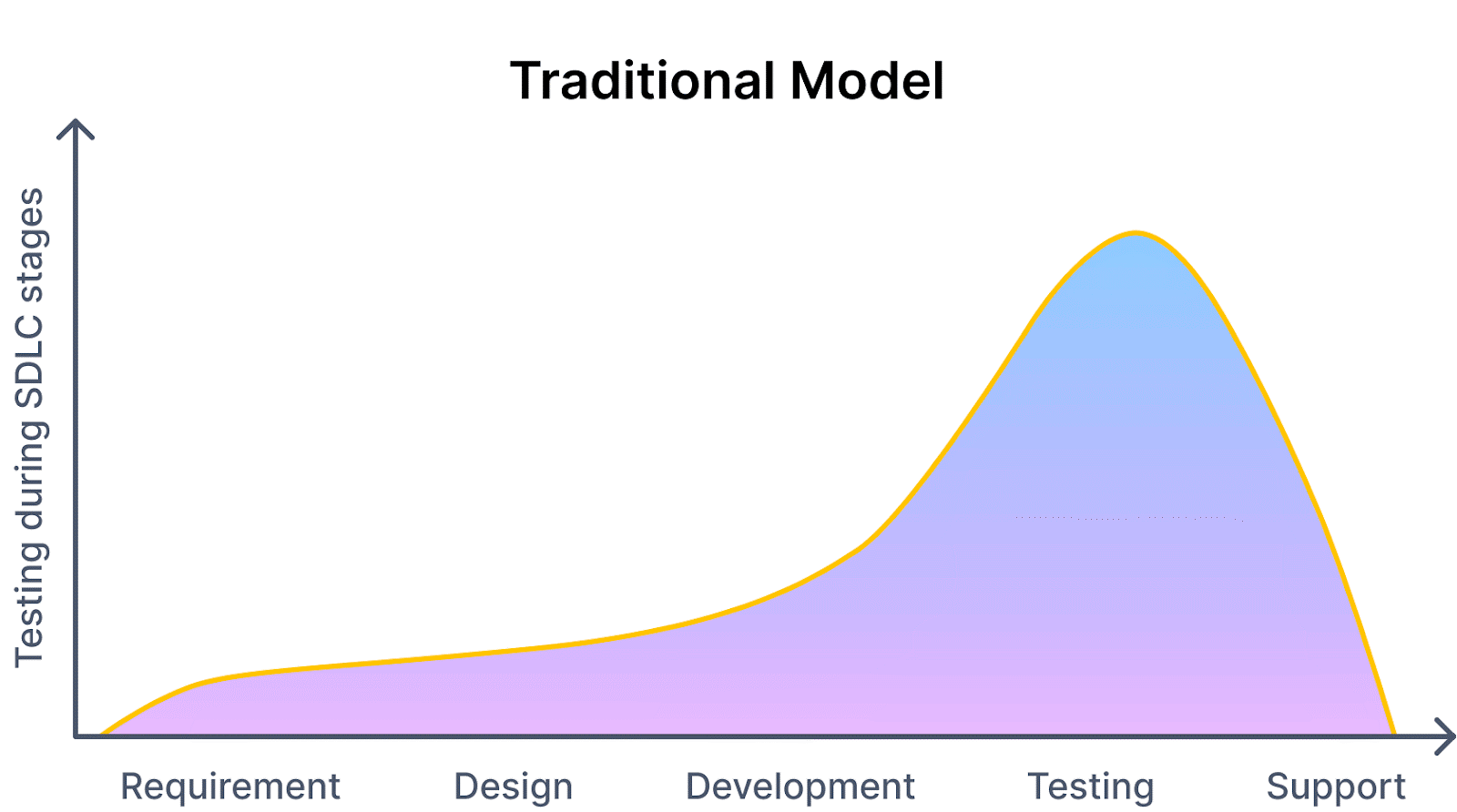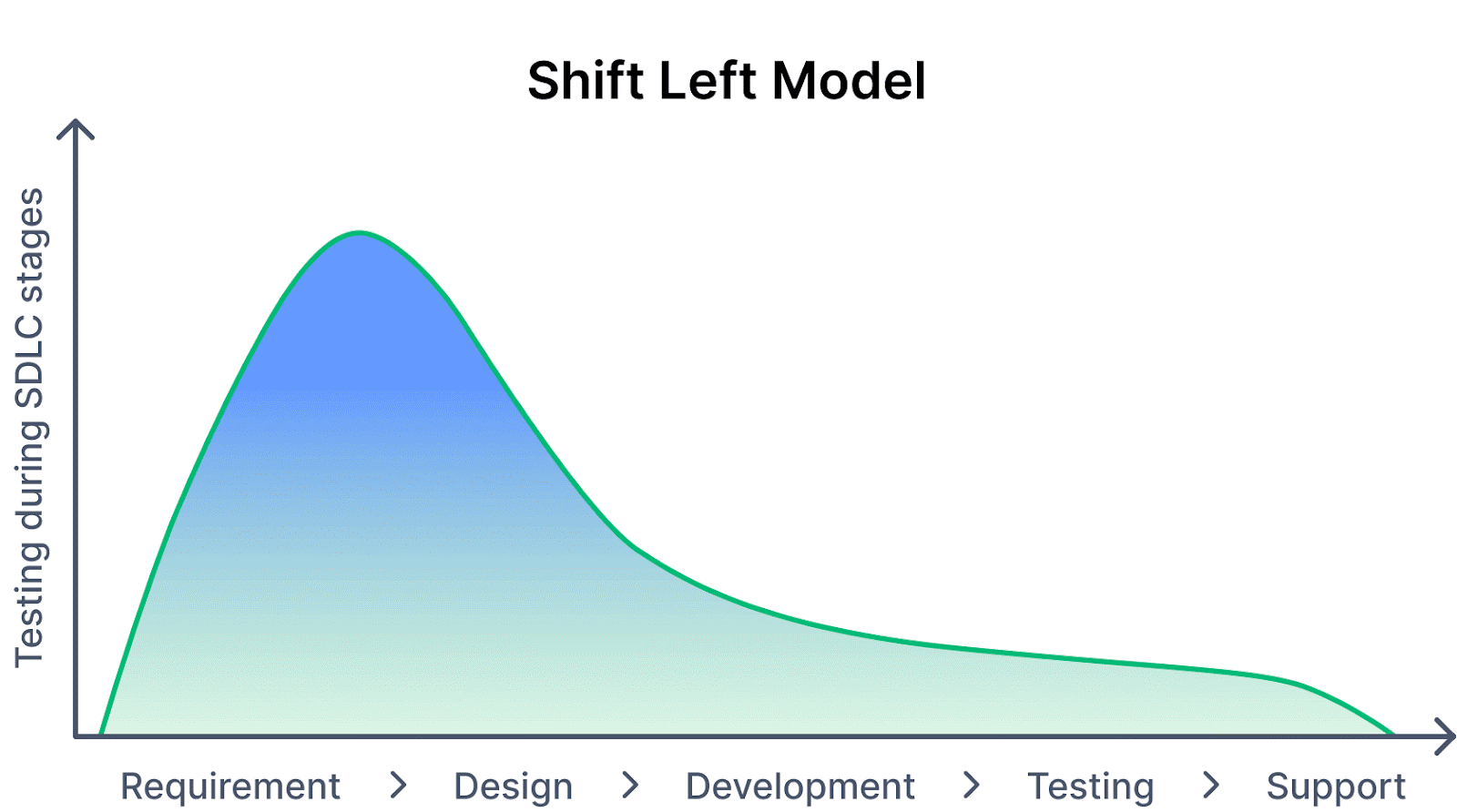Why Does DevOps Recommend Shift-Left Testing Principles?

DevOps stresses the importance of shift-left testing principles for various reasons. Read on to learn about them.
Companies are using DevOps to respond quickly to changing market dynamics and customer requirements.
In any case, the biggest bottleneck in implementing a successful DevOps framework is testing.
Many QA organizations leverage DevOps frameworks but still prefer to test their software manually. Unfortunately, this means less visibility and project backlogs, eventually leading to project delays and cost overruns.
Smaller budgets and the desire for faster delivery have fueled the need for better approaches to development and testing. With the right testing principles, DevOps can help shorten the software development lifecycle (SDLC), but not without costly mistakes.
Many organizations are adapting their traditional sequential approach to software development to be better equipped to test earlier and at all stages.
Everyday Test Automation Challenges
- Development Time – Many companies think about developing their test automation frameworks in-house, but this is usually not a good idea because it is time-consuming and would cost you significant capital to develop it from scratch.
- Learning Curve – Companies that use code-based open-source tools like Selenium rely on tech-savvy people to manage their test automation framework. This is a big problem because non-technical business users may find it difficult and time-consuming to learn the tools. In addition, technical users and teams have more important tasks to perform than testing.
- Maintenance Costs – Most test automation tools use static scripts, which means they cannot quickly adapt to changes that occur due to UI changes in the form of new screens, buttons, user flows, or user input.
What Is the Shift-Left Strategy?
It is part of an organizational pattern known as DevSecOps (a collaboration between development, security, and operations) that ensures application security at the earliest stages of the development lifecycle.
The term “shift left” refers to moving a process left on the traditional linear depiction of the software development lifecycle (SDLC). In DevOps, security and testing are two of the most commonly discussed topics for shifting left.
Shift Left Testing
Testing applications was traditionally done at the end of development before they were sent to security teams. Applications that did not meet quality standards, did not function properly, or otherwise did not meet requirements, would be sent back into development for additional changes. It resulted in significant bottlenecks during the SDLC and was incompatible with DevOps methodologies, which emphasize development velocity.
As a result of shift left testing, defects can be identified and fixed much earlier in the software development process. This streamlines the development cycle, dramatically improves quality, and enables faster progression for security analysis and deployment to later stages.
Shift-Left Security
Security testing has become a standard practice in recent years following application testing in the development cycle. At this point, various types of analysis and security testing would be conducted by security teams.
Security testing results will determine whether the application can be deployed into production or if it must be rejected and returned to developers for remediation. Due to this, long delays in development occurred, or the risk of releasing software without necessary security measures increased.
Shifting security left means incorporating security measures throughout the development lifecycle rather than at the end. By shifting security left, the software is designed with security best practices integrated. Potential security issues and vulnerabilities are identified and fixed as early as possible in the development process, making addressing security issues easier, faster, and more affordable.
It is no secret that IT has shifted left over the last two decades. It is possible to operate development infrastructure on a self-service basis today because it is fully automated:
- With AWS, GCP, or Azure, developers can easily provision resources without involving IT or operations.
- CI/CD processes automatically create, stage, and deploy test, staging, and production environments in the cloud or on-premises and tear them down when they are no longer required.
- CloudFormation and Terraform are widely used to deploy environments declaratively using Infrastructure-as-Code (IaC).
- With Kubernetes, organizations can provision containerized workloads dynamically using adaptive, automated processes.
As a result of this shift, development productivity and velocity have increased tremendously, raising serious security concerns. The fast-paced environment leaves hardly any time for post-development security reviews or analysis of cloud infrastructure configurations. As a result, it is often too late to fix problems that are discovered before the next development sprint.
What Is the Shift-Left Testing Principle?
When developers test early in the development cycle, they can catch problems early and address them before they reach the production environment. By discovering issues earlier, developers don’t waste time applying workarounds to flawed implementations, and operations teams don’t have to maintain faulty applications. To improve the quality of an application, developers can identify the root cause of issues and modify the architecture or underlying components.
The shift left approach to testing pushes testing to the left, or the earlier stages of the pipeline. By doing this, teams can find and fix bugs as soon as possible during the development process.
In addition to increasing collaboration between testers and developers, shift left testing makes identifying key aspects that need testing early in development a whole lot easier.


A major benefit of shifting testing is that testers are involved in the whole cycle, including the planning phase. Testing becomes part of the developer’s day-to-day activities as they become competent in automated testing technologies. Software is designed from the ground up with quality in mind when testing is part of the organization’s DNA.
Benefits of Implementing Shift-Left Strategy
A key benefit of “shift-left” testing is that it reduces overall development time. However, two key DevOps practices must be implemented to shift left: continuous testing and continuous deployment.
Increased Speed of Delivery
It’s not rocket science that the sooner you start, the sooner you finish. Therefore, identifying critical bugs early in the Software Development Cycle allows you to fix them sooner and more efficiently. The result is a significant decrease in the amount of time between releases and a faster delivery time.
Improved Test Coverage
Starting with the test execution right at the start of the development process, all software features, functionalities, and performance can be quickly evaluated. Test coverage percentages increase naturally when shift left testing is performed. The overall quality of the software is significantly enhanced by increased test coverage.
Efficient Workflow
Ultimately, shifting left is worth the effort and time it takes to implement. This allows the QA team to go deeper into the product and implement innovative testing solutions. Furthermore, it allows the testing team to become more comfortable with the tools and techniques involved. In addition, shift left testing simplifies several aspects of software development.
Lower Development and Testing Cost
Debugging is one of the most difficult aspects of software development. Usually, the cost of fixing a bug increases significantly as the software progresses in SDLC. Therefore, the earlier you find your bugs, the easier they are to fix.
Let us take the example of a payment app that discovers a
security vulnerability only after the release of its latest app version. Sure,
it would have cost some more if the team had found the vulnerability earlier in
development. But now, the company will have to spend significantly more time,
effort, and money to fix the problem. In addition, the complexity of
implementing changes in a production environment makes it difficult to do
anything after the fact, not to mention the associated total cost of late
maintenance.
Gartner estimates the cost of network outages at $5,600 per minute – a total of
over $300,000 per hour.
Improves Product Quality
The shift left testing approach positively impacts overall code quality with rigorous and frequent code quality checks. In addition, it facilitates timely correspondence between stakeholders, developers, and testers and ensures timely feedback, which helps improve code quality. This means that your customers receive a stable and high-quality end product.
Also, you can listen to Siddharth Kaushal, who shared an idea of using shift-left testing and how automation tools can aid the idea of shift-left testing to make the process easily consumable by agile teams.
Conclusion
Once you mix Shift Left with leading DevOps practices – Continuous Testing and Continuous Development – you lay the foundation for Shift Left to win. Moreover, Shift Left is essential in a DevOps environment because.
- Teams discover and report bugs quickly.
- Features are released quickly.
- The quality of the software is outstanding.
We Provide consulting, implementation, and management services on DevOps, DevSecOps, Cloud, Automated Ops, Microservices, Infrastructure, and Security
Services offered by us: https://www.zippyops.com/services
Our Products: https://www.zippyops.com/products
Our Solutions: https://www.zippyops.com/solutions
For Demo, videos check out YouTube Playlist: https://www.youtube.com/watch?v=4FYvPooN_Tg&list=PLCJ3JpanNyCfXlHahZhYgJH9-rV6ouPro
If this seems interesting, please email us at [email protected] for a call.
Recent Comments
No comments
Leave a Comment
We will be happy to hear what you think about this post